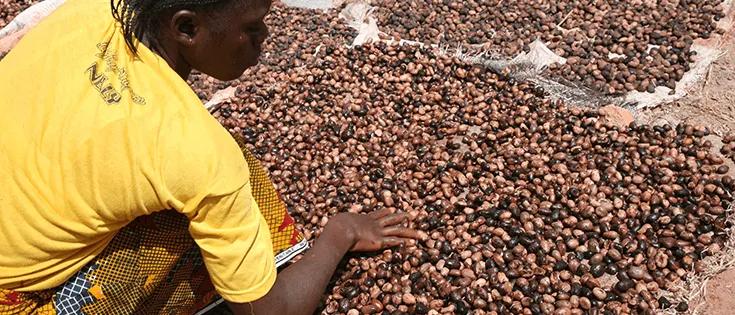Benin
Health
Training dogs to detect breast cancer, a method for screening disadvantaged women in Benin
The project, led by Cirad, and coordinated by the researcher Léa Fulloy, plans to produce stoves using shea nut shells as an alternative to wood. This new technology could be used by cooperatives and women–led organizations, which are often in charge of collecting, boiling and shelling shea nuts in Burkina Faso. FID’s funding will enable existing stoves to be fueled with shea shells and evaluate their efficiency with local populations.
The FID funding allowed several studies to be carried out on the feasibility of the project, including an in-depth field survey on current boiling practices to measure the emissions linked to this boiling, as well as a market study on the use of such stoves.
Project deployed by:


Shea nuts are one of the main agricultural products of southwestern Burkina Faso. Producers mainly use wood-burning stoves to boil the shea nuts and make butter out of them. These stoves require a lot of wood, and therefore increase deforestation while generating toxic fumes that can be harmful to the health of the women using them on a daily-basis.
The French Agricultural Research Centre for International Development (Cirad) carries out this project, which aims to adapt wood-burning stoves to the use of a different kind of fuel, shea nut shells, which are normally discarded after being boiled. By using shea nut shells as fuel, this project aims to promote a new cooking method respectful of the environment and of the health of women producers.
The FID funding was intended to carry out the preliminary studies necessary to optimize existing improved combustion stoves.
Surveys were conducted in 3 regions (Southwest, Cascades, and Hauts-Bassins) and 9 villages in Burkina Faso. At the end of the data collection, 652 women were surveyed, including 592 shea producers and 60 engaged in other activities requiring cooking (catering, beer making, etc.). At the same time, individual interviews were conducted to provide additional information on the sociocultural context and potential challenges related to the introduction of new cooking equipment.
The first part of the surveys focused on the use of shea nut shells, in order to understand whether their use as an energy source had already been considered:
Future research on the subject may demonstrate whether the decomposition of shea shells in manure is beneficial to the land, or whether it only allows families to get rid of them.
The extensive market research carried out by the project team showed that:
Regarding the willingness to pay for the purchase of an improved stove: 43% of the women surveyed would be willing to pay more (around 20%) for an improved stove allowing the combustion of shea shells, 88% of women would be willing to benefit from payment facilities of up to 6 months to finance this purchase.
The diversity of responses on willingness to pay demonstrated the need for flexibility in commercial proposals.
This supports the fact that women are aware of the savings they could make by using this innovative stove, fueled by shea shells they usually discarded, representing savings on the purchase and collection of other fuel sources. However, setting up suitable payment plans is crucial to maximize the acceptance of these new technologies.
During a knowledge-sharing workshop held after the survey, it was decided that for the next phase of the project, the team would focus on developing an improved combustion stove that could use both shea shells and wood as fuel, for mixed uses (boiling shea shells and domestic use). This combustion stove would be well suited to the daily lives of users, who could use the shea shells and then wood as a supplement when the shells were no longer available. The potential commercialization of these combustion stove would also be coupled with training and awareness-raising activities on good cooking practices that are more respectful of the environment.
However, activities had to be interrupted early following the decision to stop French public funding to Burkina Faso .
The kick-off meeting for the KarBur project was held on July 10, 2023. A data collection campaign has already begun in order to confirm current shea nut scalding practices, existing disincentives to the use of hulls as fuel and smoke emissions with current stoves.
Do you have any questions about FID? Check out our Q&A!
Projects
Projects funded by FID